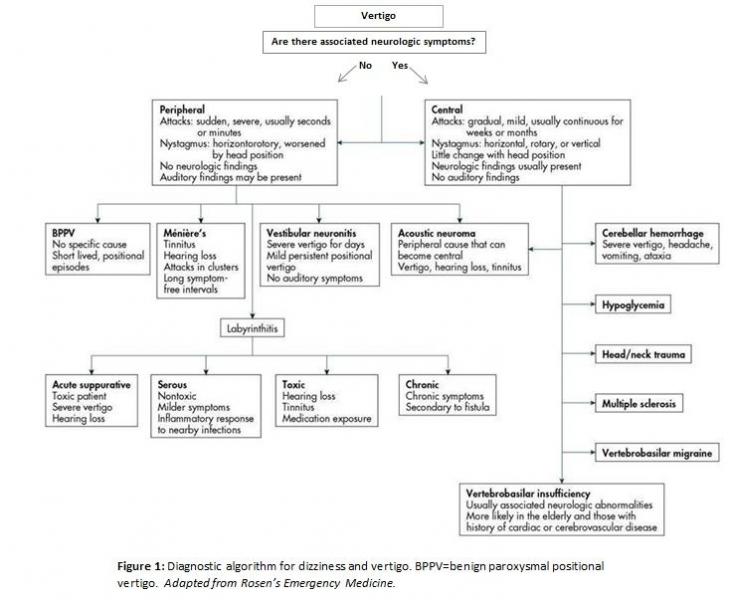Vertigo and Complaints of Dizziness - #19
Take QuizDifferentiate peripheral and central causes of dizziness.
Vertigo in older persons could be associated with a variety of cardiovascular and neurosensory conditions, and with use of medications[2]. Initial evaluation should focus in differentiated peripheral from central causes to minimize morbidity and mortality associated with serious cardiovascular and neurovascular conditions.
Physical examination: A complete neurologic examination, including vestibular testing and the characteristics of nystagmus are important to help differentiate between central and peripheral causes of vertigo.
TABLE 1
|
Characteristics of Nystagmus [3] |
||
|
Central |
Peripheral |
|
|
Direction |
Multi-directional |
Unidirectional |
|
Fixation |
No changes |
Inhibited |
|
Duration |
> 1 minute |
< 1 minute |
|
Latency |
Rare |
Common |
|
Fatigability after provocative testing |
No |
Yes |
TABLE 2
|
Vestibular testing |
|
|
Maneuver |
Positive result |
|
Dix-Hallpike Maneuver Video |
For benign paroxysmal positional vertigo (BPPV): Up-beating nystagmus to the stimulated side, rotatory component to the affected side, latency of 2-15 seconds, lasts 15-45 seconds, fatigues easily. |
|
Head trust test Video |
Catch-up saccade movement when rotated towards the affected side. |
|
Fukuda stepping test Video |
More than 45 degrees of rotation towards the affected side |
A simplified approach to the differential diagnosis of a patient with vertigo is illustrated in the following algorithm.

Emergency department visit.
Assess elderly patient complaining of vertigo with complexities of many underlying etiologies.
Vertigo is an episodic spinning or rotational sensation when one is stationary caused by disorders of the vestibular system.
Dizziness and vertigo are common presenting complaints in the ambulatory care setting, with an estimated 7.5 million patients seen each year1. The prevalence of vertigo increases with age (10% for every 5 years of age), and accounts for 54 % of dizziness in primary care [2]. Approaching a patient with dizziness is challenging due to the non-specific presentation and its broad differential diagnosis. As reported by Sloane et al, to facilitate the assessment of patient complaint of dizziness, Drachman and Hart (’76) classified dizziness into four categories: vertigo, pre-syncope, disequilibrium, and other (non-specific) [1].
Recognize urgent vs. non-urgent causes of vertigo in the elderly.
Review of Systems (ROS)
Geriatric Topics
ACGME Compentencies
Science Principles
- Sloane PD, Coeytaux RR, Beck RS, Dallara J. Dizziness: state of the science. Ann Intern Med. 2001;134(9 Pt. 2):823-832. http://www.ncbi.nlm.nih.gov/pubmed/?term=dizziness+state+of+the+science+sloane
- Kroenke K, Lucas CA, Rosenberg ML, Scherkman B, Herbers JE Jr, Wehrle PA, Boggi JO. Causes of persistent dizziness. A prospective study of 100 patients in ambulatory care. Ann Intern Med 1992; 117:898-904. http://www.ncbi.nlm.nih.gov/pubmed/1443950
- Hoffman RM, Einstadter D, Kroenke K. Evaluating dizziness. Am J Med 1999; 107(5):468-78. http://www.ncbi.nlm.nih.gov/pubmed/10569302
- Burt CW, Scheppert SM. Ambulatory care visits to physician offices, hospital outpatient departments and emergency departments: United States 1999–2000. Vital Health Stat 13 2004; 1-70. http://www.ncbi.nlm.nih.gov/pubmed/15499797
- Lawson J, Fitzgerald J, Birchall J, Aldren CD, Kenny RA. Diagnosis of Geriatric Patients with Severe Dizziness. Journal of the American Geriatrics Society, 1999, 47(1): 12-7. http://www.ncbi.nlm.nih.gov/pubmed/9920224
- Rosen’s Emergency Medicine: Concepts and Clinical Practice 7th Ed., Editor-in-Chief John A. Marx, Philadelphia: Mosby/Elsevier, 2009.
- Tintinalli’s Emergency Medicine, A Comprehensive Study Guide 7th Ed., Editor-in-Chief Judith E. Tintinalli, New York: McGraw-Hill, 2004.
Users are free to download and distribute Geriatric Fast Facts for informational, educational, and research purposes only. Citation: Catherine Tsufis, Kathryn Denson MD, Kathleen Williams MD, Gabriel Manzi MD, Fast Fact #19:Vertigo in the Elderly Patient Complaining of Dizziness. September, 2012.
Disclaimer: Geriatric Fast Facts are for informational, educational and research purposes only. Geriatric Fast Facts are not, nor are they intended to be, medical advice. Health care providers should exercise their own independent clinical judgment when diagnosing and treating patients. Some Geriatric Fast Facts cite the use of a product in a dosage, for an indication, or in a manner other than that recommended in the product labeling. Accordingly, the official prescribing information should be consulted before any such product is used.
Terms of Use: Geriatric Fast Facts are provided for informational, educational and research purposes only. Use of the material for any other purpose constitutes infringement of the copyright and intellectual property rights owned by the specific authors and/or their affiliated institutions listed on each Fast Fact. By using any of this material, you assume all risks of copyright infringement and related liability. Geriatric Fast Facts may not be reproduced or used for unauthorized purposes without prior written permission, which may be obtained by submitting a written request to: Medical College of Wisconsin, Dept. of Medicine, Division of Geriatrics and Gerontology, 8701 Watertown Plank Road, Milwaukee, WI 53226. Note the Geriatric Fast Facts may contain copyrighted work created under contract with government agencies, foundations, funding organizations and commercial companies, etc. If a particular author places further restrictions on the material, you must honor those restrictions regardless of whether such restrictions are described in this mobile app.